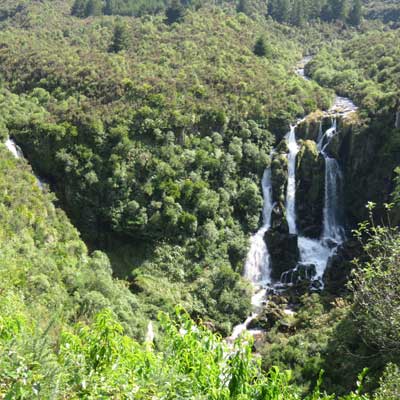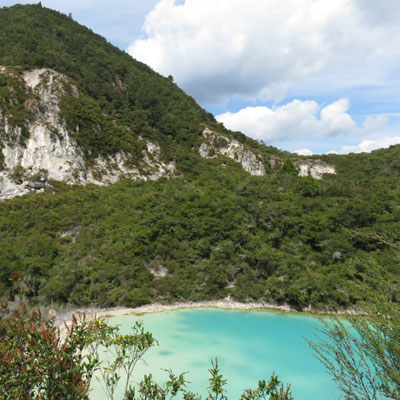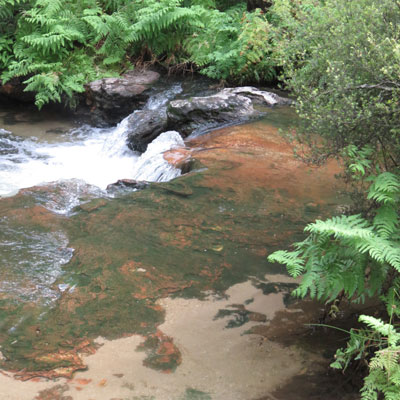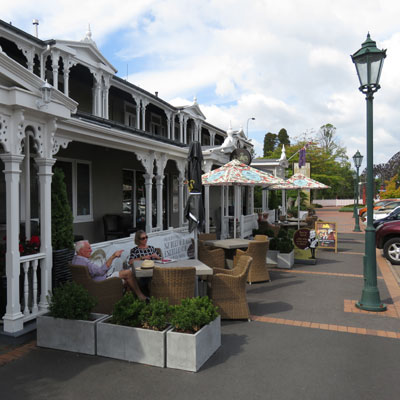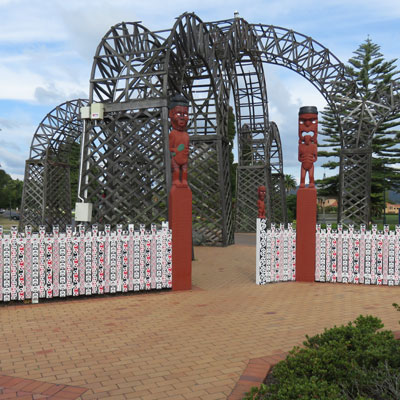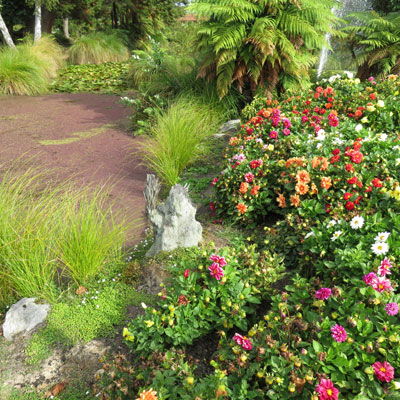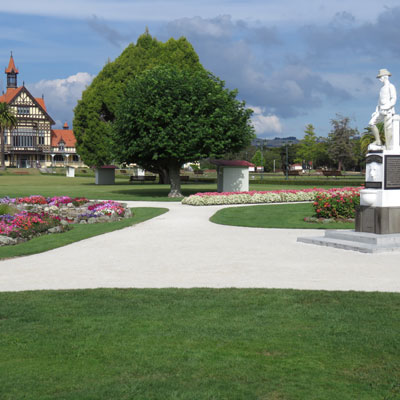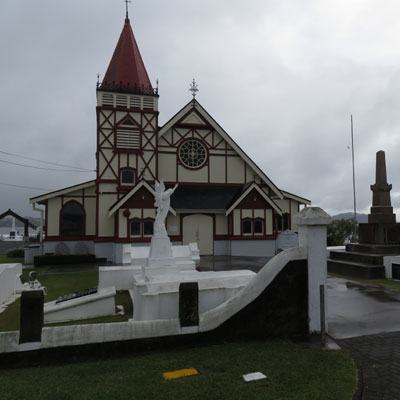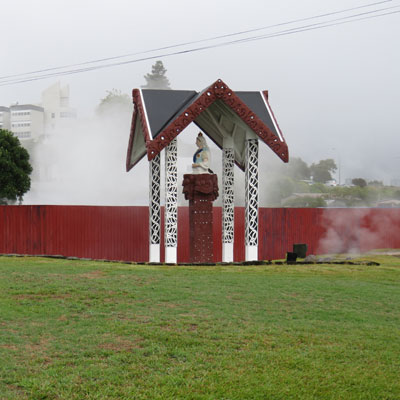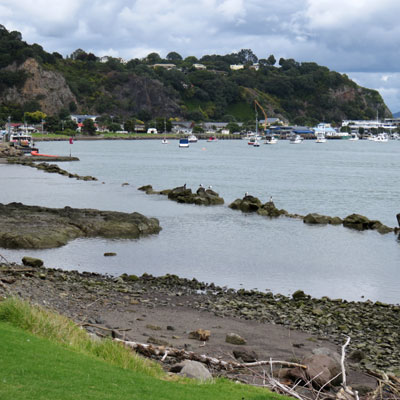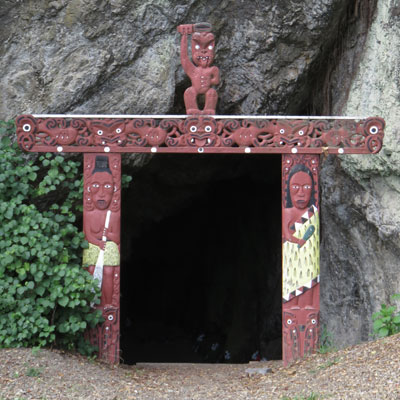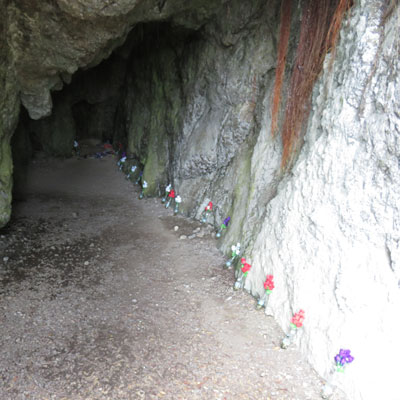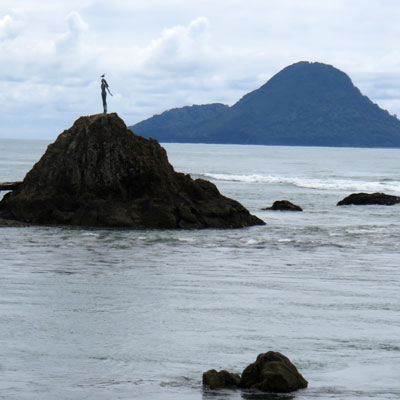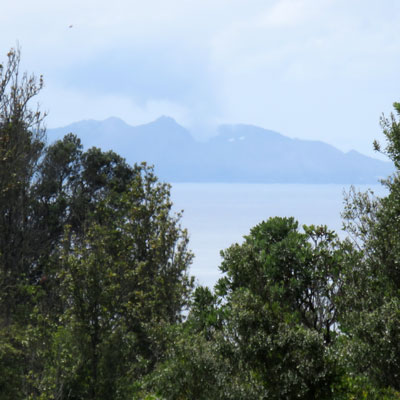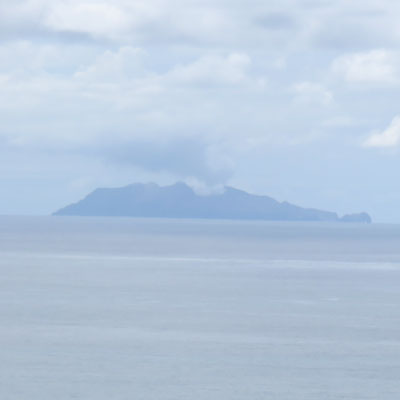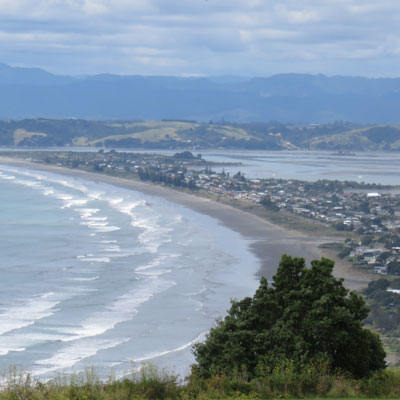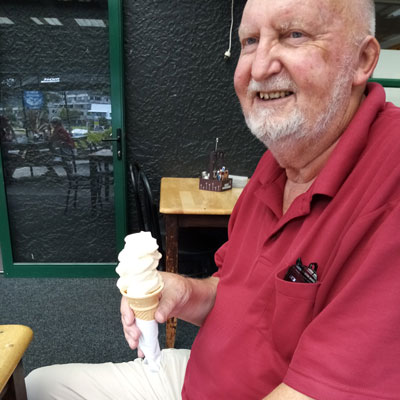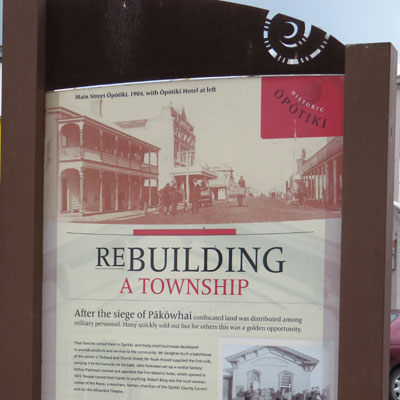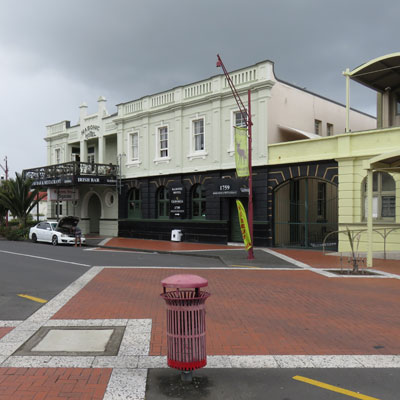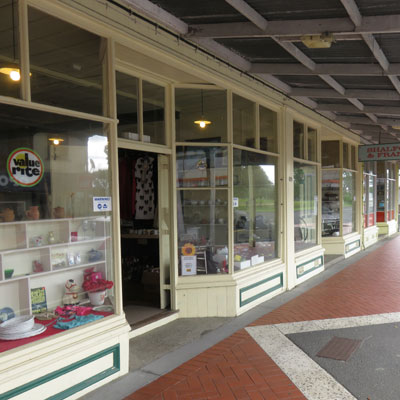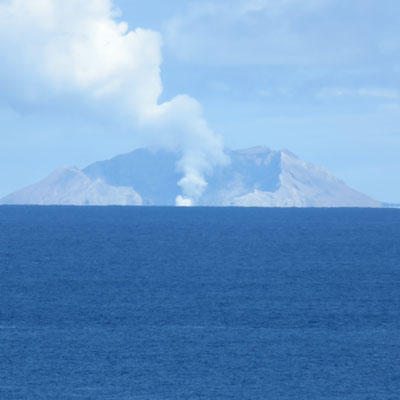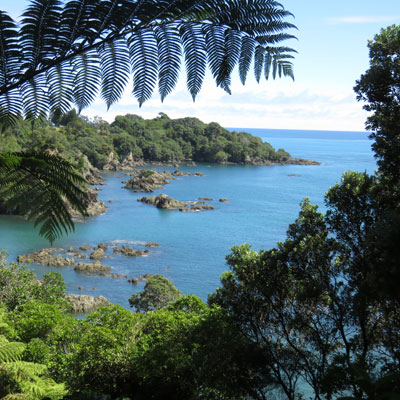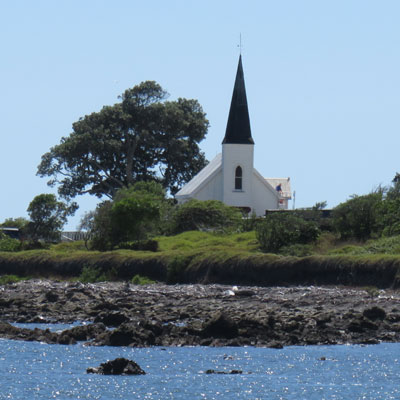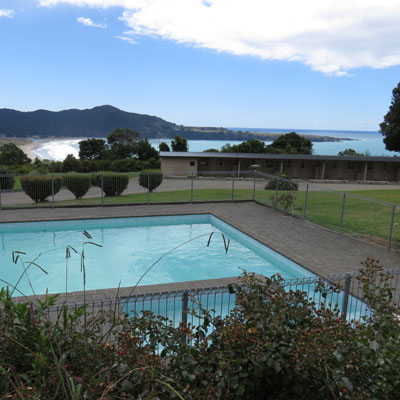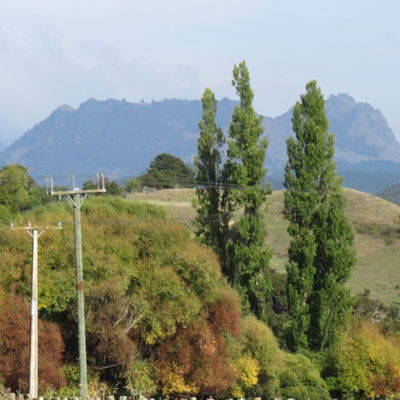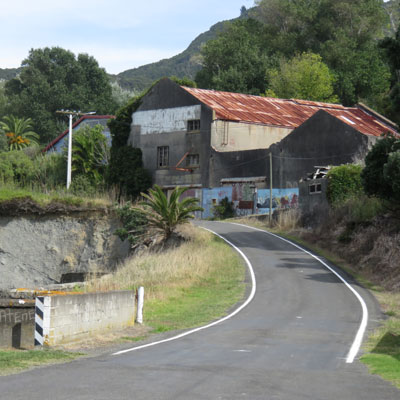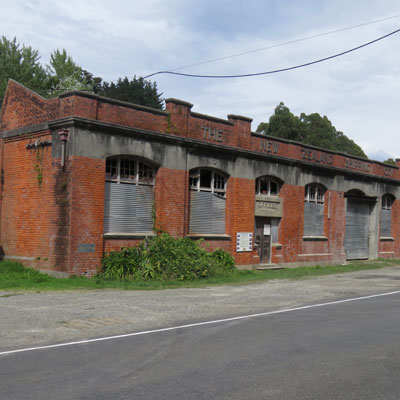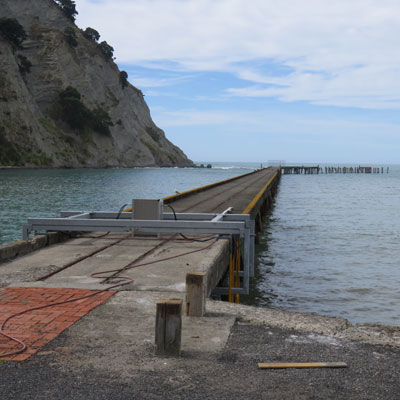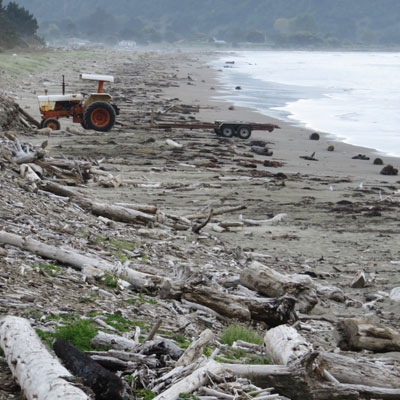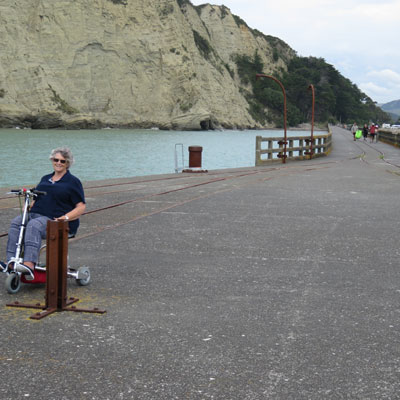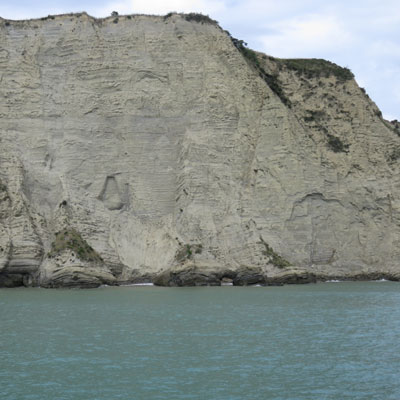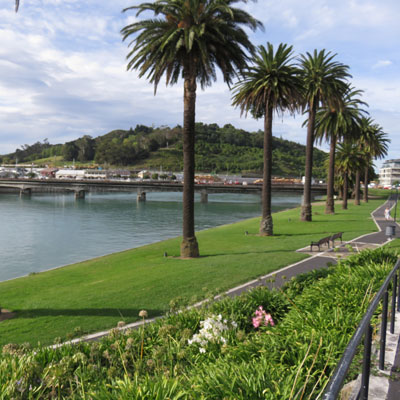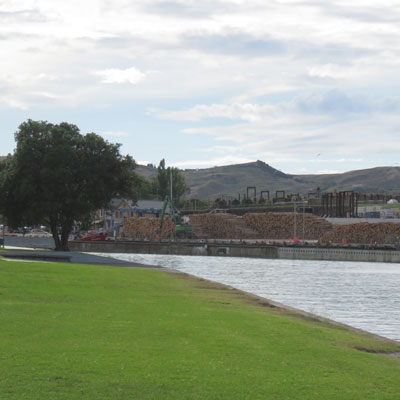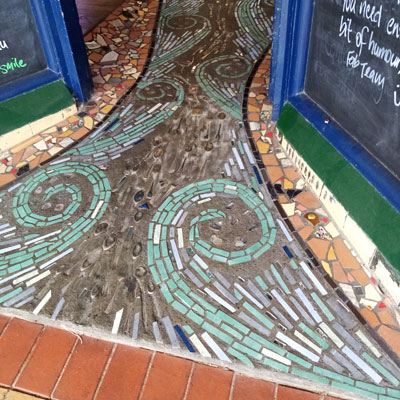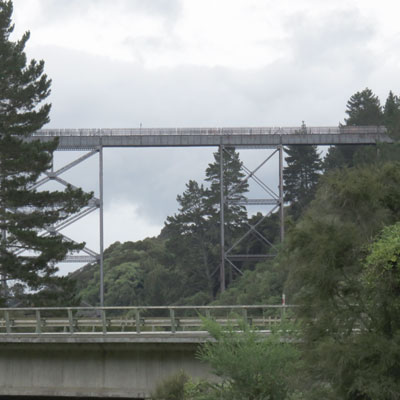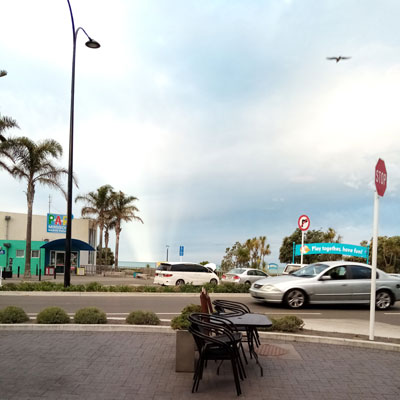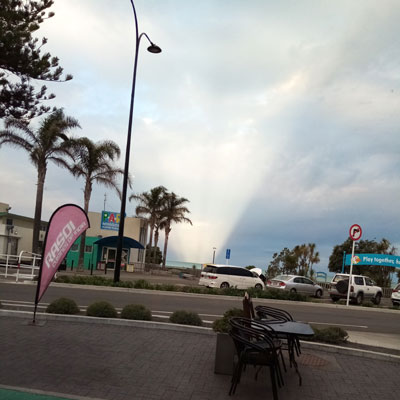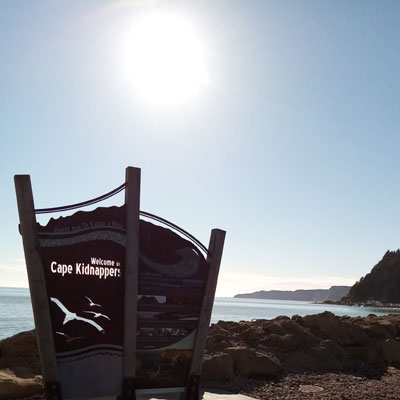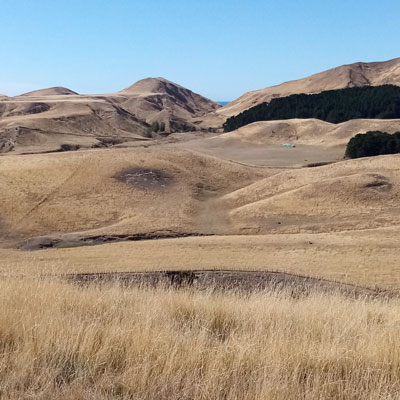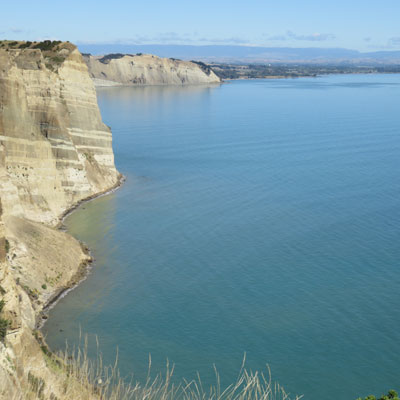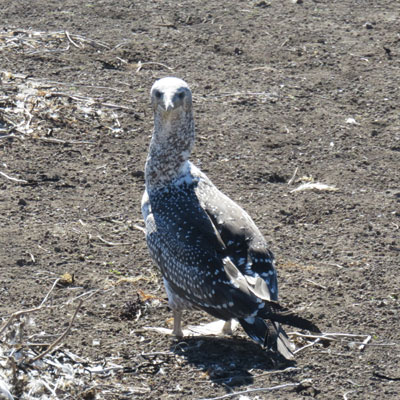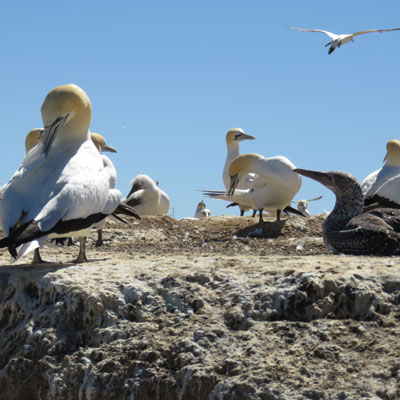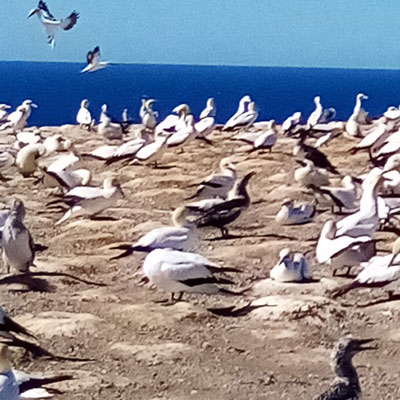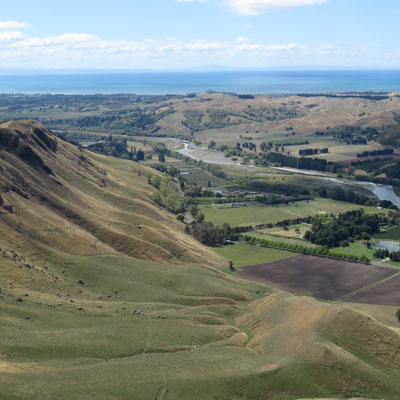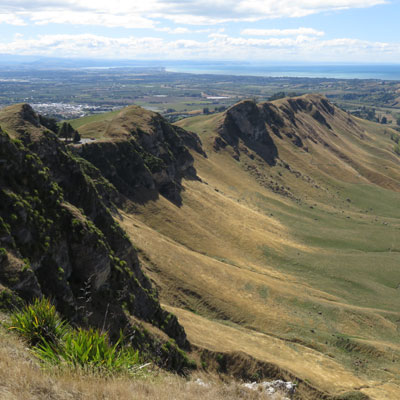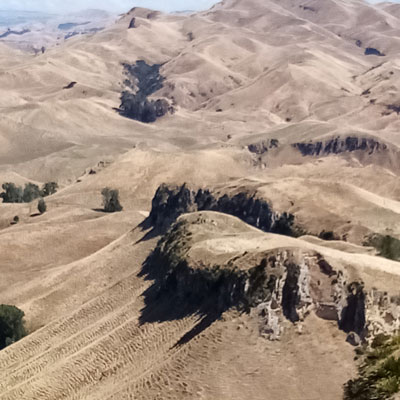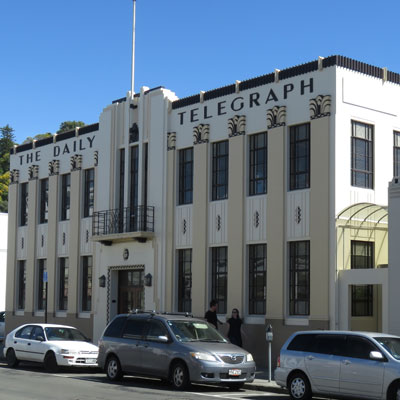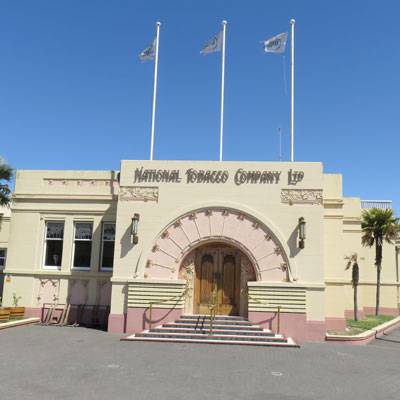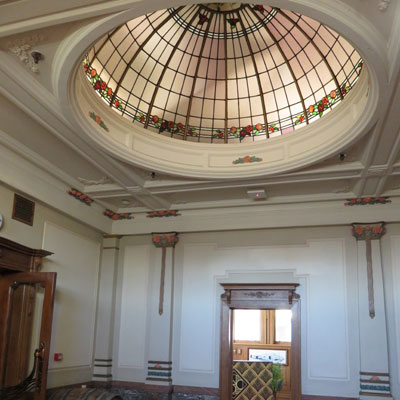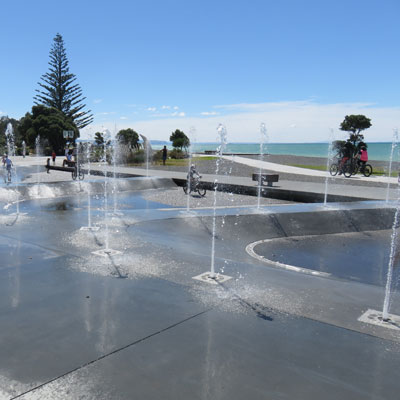A tour around the East Cape of the North Island of New Zealand - driving round-trip from Napier in March 2021
East Cape, North Island 2021
Following our visit to the west coast of the South Islandl we decided to take another trip to a part of the North Island that we had not yet explored.
Day -1: Friday
The evening before our holiday was spent rescheduling flights and transfers
when Air NZ cancelled our flight, by email, with 12 hours’ notice. They
did not say why other than for ‘Operational reasons’. We subsequently
found out that there had been fog in Blenheim and the planes were in the
wrong place. How much better it would have been for our tempers and Air
New Zealand’s reputation if this had been explained in the initial contact.
In addition, it was sheer luck that we saw the email at 9pm and were able
to act upon it. Others, who were travelling for work, did not get the
message and therefore presented themselves at the airport 3 hours early.
A text or phone call to affected passengers, as soon as the situation
became apparent, would have been much more sensible.
Day 1: Saturday. Kerikeri to Napier
We flew from Kerikeri to Napier via Auckland. Good flights and safe touchdown
in spite of a rather windier landing at Napier than we would have liked.
We were able to get a taxi to the Apex car rental office and the pick-up
went smoothly. Our charming taxi driver insisted on helping Martin stow
our luggage and my mobility paraphernalia in the hire car before he would
leave us. Checked in at Quality Inn Napier and went for a wander to see
what was nearby - our changed flight time meant that we had lost half
a day in Napier so we only had time for a short stroll before going to
the Restaurant Indonesia for an excellent rijsttafel. This brought back
good memories of our time in Singapore and Malaysia - and Indonesia, of
course. We were tired from travelling and eating too much, so decided
on an early night. We were awoken at 11.55am, however, by a loud and boozy
party in the hotel pool area, which went on until 7am. It transpired that
they were the House of Shem reggae band and entourage, celebrating after
a successful concert. There were no hotel staff on premises but some other
guests called the security number but they were not interested. We were
not amused. The receptionist very embarrassed when we checked out and
gave 50% off our room rate. We were grateful but would have preferred
the sleep!
We were very glad we had decided to fly rather than drive the whole way as that day, Auckland was moved into Level 3 Covid Lockdown, with no one allowed into, or out of, Greater Auckland, even non-stop on the motorway. As the only way to get to the rest of the country form Northland is via Auckland, that effectively cut our region off too. We were allowed to transit through Auckland airport as it is a controlled environment, but friends who were also travelling south for a holiday, were forced to cancel their trip as they were driving and a holiday was not deemed an important enough reason to be given a dispensation to traverse the locked down area.
Day 2: Sunday. Napier to Rotorua via Taupo
We drove to Rotorua, via a quick lunch stop in Taupo, through interesting
volcanic scenery, blue crater lakes and beautiful waterfalls. Creeks were
lined with coloured rocks; one of them giving the water a pink appearance
was aptly named Kerosene Creek.
In Rotorua, Prince’s Gate Hotel was a nice surprise in that it looked even more charming than in the publicity photos. The building has a chequered history which could be described as ‘Grand to Banned to Grand again’. You can read more about it here. Situated right beside Government Garden’s Crown-shaped gates, we had a lovely large room decorated and furnished in keeping with the era of the hotel complete with not one but two chandeliers - though there was a mercifully modern bed.
We enjoyed exploring the gardens with their exuberant flower beds, ponds,
birds and emerald green grass forming a perfect foreground for the terracotta
coloured ‘Tudor’ and blush-pink ‘Tuscan’ buildings housing the thermal
baths, museum, cultural shows and other kindred facilities which make
this spa town a magnet for tourists and those in search of a cure for
whatever ails them. Because they are currently being earthquake-proofed,
these buildings are not currently open to the public, so we were unable
to go inside. However, as the attraction, for us, was the architecture
we were glad to be able to see them at their best, without the usual hordes
of visitors from all over the world, who seem to arrive by the coach-load
every ten minutes in normal times.
There’s not much for which to thank Covid but we were selfishly delighted
to have everywhere we visited almost to ourselves. We do appreciate that
the businesses which are so clearly missing the trade these visitors brings
will not agree with us on this point.
We went for a walk round Rotorua in the early evening to find a restaurant for dinner but although there were plenty of places offering sustenance, they all seemed much of a muchness and heavy on the fried food (and loud music to go with it), so we decided to eat at the hotel - a splendid choice. First class, real food perfectly cooked and a good choice of wines, all beautifully served in a very ‘swellegant’ dining room. We wished we’d brought posher outfits with us! A good night’s sleep saw us refreshed and ready for a leisurely start next day.
Day 3: Monday. Rotorua to Whakatane and Ohope via Lake Rotoiti
It was a wet morning, so we were glad we had explored the gardens of Rotorua
the day before. We still had to visit the historic, but still very much
alive, Maori village of Ohinematu, dominated by St Faith’s, the first
Christian church in Rotorua. The church has an extremely interesting history,
which you can read about here.
It is also renowned for its beautiful stained glass windows. Unfortunately
we were unable to enter as it was too early for the doors to be open,
so we could only see them from the outside, and in very dull conditions,
but it was easy to imagine their beauty and to see the traditional Maori
designs and colours. In the cemetery, the graves are raised above ground
because of thermal activity. These are mostly the graves of soldiers who
served in 28 (Maori) Battalion during the Second World War and a very
moving sight.
Deciding to get breakfast in one of the many advertised cafes along our route, we left Rotorua for the comparatively short drive to Whakatane, passing Lake Rotoiti and Lake Rotoma en route. It was a pretty drive but with no particular photo-opportunities, so we just enjoyed what we saw and pressed on to Whakatane. We arrived mid-morning and went in search of breakfast, all the promised cafes proving either elusive or firmly closed; a sad testament to the damage Covid-19 has done to the economy of so many small places reliant on tourism. Fortified, we set of to explore the immediate area and also out to Ohope Beach, recently voted New Zealand’s Best Beach. We don’t know who voted for it, but they had clearly never ventured north as any one you care to pick in our area would beat it into a cocked hat! It was interesting to see it, though, and the dormitory town which has grown along the sand spit that separates the beach from the Ohiwa Harbour. One thing Ohope Beach does offer is massive, fresh fruit ice creams, as our photo of Martin tackling a small, mango cone illustrates!
Back in Whakatane, we checked in to White Island Rendezvous Motel, which
was very comfortable and ideally situated for visiting both the town and
the sea views and rocks. The Lady on the Rock sculpture was beautiful,
if smaller than I expected. The renowned and beautifully carved entrance
to Muriwai’s cave was nearby and the jars of flowers lining the passage
into the cave itself were a delightful surprise. The views of Whale Island,
which is a wildlife sanctuary and nature conservancy area, are excellent
and one can also see the smoke of White Island in the distance. On this
day, the smoke was light grey in colour and seemed to rise lazily from
the crater, though later in the trip we saw it with copious billows of
white smoke rising vigorously straight up into the sky. We have been told
it does vary from day to day, and it is when it stops smoking that there
may well be an eruption or at least some great seismic activity.
Whakatane is a vibrant town which, although badly affected by the tragic
loss of life of locals and visitors when Whakaari/White Island erupted
and by the Covid epidemic, has managed to retain some of the prosperity
that other tourism centres have lost.
We found during our travels that the relative prosperity of a town or settlement could be gauged by the number and quality of its cafes and restaurants. Whakatane had numerous excellent examples of both and if you are ever there, we highly recommend Roquelles, where we had a truly memorable dinner… you won’t go wrong with the confit duck and the trio of fish, if you’re spoilt for choice as, we were!
Day 4: Tuesday. Whakatane to Hicks Bay via Opotiki
With a long drive ahead of us, we left Whakatane early and were in the
town of Opotiki in time for breakfast. Opotiki is the home town of Beth,
a dear friend of ours, and she was able to tell us a bit about it. St
Steven’s Church, which has an unusual history about which you can read
here, contains unique memorials and narrative windows. Sadly, we were
there too early in the day to find the church open so were unable to see
them. This is the church where Beth and her sister sang in the choir as
children and knowing this connection, we just enjoyed looking at it from
the outside, even though we couldn’t see everything the church had to
offer. Near to the church, there are many historical buildings from the
grand Masonic Hotel and municipal edifices and a theatre, to humble shops.
They have made this area a ‘living museum’ and an active historical society
and Council are making valiant efforts to restore as many as possible
of the lovely old buildings to their former glory. This is not a wealthy
area and it doesn’t get a great income from tourism, but there is certainly
a will to improve their town and revitalise the town centre businesses
which have suffered so much over the past year or so. The new café at
which we had an excellent breakfast was a good start and its obvious success
will be a great incentive for other businesses to follow suit.
The drive from Opotiki to Hicks Bay was lovely and as well as the beauty of the rocky bays and rural scenes of horse grazing, offered frequent and dramatic views of White Island almost all the way, the smoke even whiter and more voluminous than before. Although cafes had been advertised, again, we found them either closed or elusive but we did find Pacific Coast Macadamias, a macadamia plantation sitting high above the delightful Whanarua Bay, where we enjoyed a ‘lunch’ of macadamia cakes and coffee. We also treated ourselves to a box of hot, roasted macadamia nuts. This was the only place for refreshment on the entire 147km drive from Opotiki. Before arriving at Hicks Bay, we passed through the settlement of Raukokore, where there is another delightful church, with a tall spire and, had it not been closed for renovations and covered in scaffolding, we might have paid it a visit. It seems that churches were off limits for us this trip!
Although there were lovely views from the garden, Hicks Bay Motel is very dated and rather musty, though the staff were very welcoming. It is in a beautiful position overlooking the bay but gives ‘middle of nowhere’ a whole new dimension. There was an interesting clientele, being mainly the road mending crews whom we had encountered all along the way from Opotiki, and whom we felt we knew quite well by the time the dinner hour came around. In fact, some of those who had controlled the stop/go signs recognised us and said ‘Hello’. That shows how little traffic there was! We had a look round the settlement at Hicks Bay and surrounds but apart from pretty scenery, there was little to detain us. We were told that the old wharf was worth a visit but a road sign now says ”only suitable for 4-wheel drive vehicles” so we didn’t risk the rental car. Dinner at the hotel was a cheerful affair, though exceedingly slow, and we enjoyed watching the antics of the road crew and wondering what the other, rather reticent, elderly couple made of it all. We think they were staying the night, as we were, to break the journey, as it was the only place to stay between Opotiki and Gisborne, which was too far to drive comfortably in one day. This was the relaxing half-way point on our East Cape Adventure.
Day 5. Wednesday. Hicks Bay to Gisborne via Tolaga Bay:
We left Hicks Bay early and made our way to Te Araroa, a small town which
services a large population of farmers and associated tradespeople. There
always seems to be a theme to our trips - the last one was rain - and
this one was an absence of cafes and open churches! There were two or
three possibilities in Te Araroa but all were either closed or closed
down. There is a huge and very ancient pohutukawa tree in Te Araroa, thought
to be the oldest and largest in New Zealand; it was certainly a magnificent
specimen. We carried on towards East Cape but were unable to go to this
furthest east point of the country (which is the first place in the world
to see the rising sun on January 1st each year). There is a 20kms of very
rough road to be covered and then quite a trek to the lighthouse and vantage
point. We had neither the inclination to wreck our hire car, nor could
we manage the hike or afford the time necessary to do so. Tikitiki township
was our next stop, where there is an historic church built in typical
Maori architectural style. It is known for its beautiful carvings, woven
panels and magnificent pulpit. However, you’ve guessed it, the church
was being renovated, was covered in scaffolding and was firmly locked.
Oh dear!
We then travelled through Ruatoria, where there is experimental hemp growing for use in medicinal cannabis. There has been some good investment into the industry and it is providing employment for a number of local people. Still no café so still no breakfast. We arrived in the small town of Te Puia Springs, desperate for coffee if not food, it being almost lunch time and the last sustenance we had was a cup of tea at 7am. Te Puia thermal springs were not open for visitors but we did see the local hospital buildings, which had originally been built at the beginning of the last century as a Health Spa, taking advantage of the medicinal properties of the hot springs. The hospital looked just like many throughout the country, built at the same time and, it would appear, all to a standard design, of local timber. We found a nice little café at the petrol station, so filled both the car and ourselves and went on our way refreshed.
Tokomaru Bay was our next stop. This was once a thriving centre for farming, forestry, trade and shipping, with a long wharf capable of accommodating passenger ships and ocean-going vessels. The imposing but overgrown ruins of the meat-freezing works, NZ Shipping Company warehouse and offices and many other relics of a bustling port are a sad reminder of better times. These old, tumbledown buildings, and the very long, semi-derelict wharf, have their own charm and there are plans in progress to at least partially restore the wharf and some of the premises.
A short drive south brought us to Tolaga Bay, in a very rugged and remote location. The high, friable sandstone cliffs with numerous caves, form a dramatic boundary to the bay. There is another very long wharf; at 660m it is said to be one of the longest concrete wharves in the Southern Hemisphere. This, like the one at Tokomaru, was able to accommodate a full range of shipping, both passenger and cargo vessels. We enjoyed walking to the end of the wharf (or riding in my case), which gave us good close up views of the cliff face and the sweep of the Bay. There was good fishing off the end of the wharf and some lucky anglers caught some good sized snapper while we watched. It was a lovely sunny day but very windy, so we felt refreshed after too long in the car.
Tolaga Bay was a popular holiday spot for Kiwis and well known for its beach and campsite. In 2018, during tremendous storms and flooding, a huge amount of ‘slash’, the branch and bark waste products left after the forests have been harvested, washed down onto the beach, completely covering the sand, ruining it and turning it into an absolute eyesore. Last year, another storm brought more of the same devastation. This was a disaster for the tourist industry, particularly as it happened right in the middle of summer at their busiest time. It has taken too long but most of the slash has finally been cleared, although some still remains at the high water mark, and this beautiful area is beginning to see the much-needed visitors return.
An attractive 55km coastal drive from Tolaga Bay took us to our next overnight spot, the city of Gisborne. We stayed at a B&B and were overwhelmed by the welcome of our hosts. The beautifully appointed suite, complete with modern bathroom and kitchen, was extremely comfortable and the vase of flowers from the garden and bowl of fruit a lovely touch. A batch of home-made ginger biscuits and rum-balls, as well as home-made marmalade and plum jam, plus stewed plums, all from the garden, took the hospitality to a whole new level. If you visit Gisborne, stay at ‘bnb95’. David, a retired academic music teacher, and Alan, an artist and potter, will make sure you are not disappointed!
Gisborne is a very busy port, mainly catering for the logging industry and the constant stream of logging trucks arriving fully laden and leaving empty, ensure that it kept going day and night. There was once a lively fishing industry here but we saw little evidence of it. The main city of the region and once a prosperous and bustling centre, Gisborne was, perhaps, the starkest example of the decline in fortunes over the past few, difficult years, particularly since Covid reared its ugly head. The main streets were certainly depressed, with the number of empty shops very noticeable. Of those which were still just holding their own, many looked far from prosperous; there were very few people out and about in the shopping streets so their demise was hardly surprising. Once-thriving restaurants and cafes had closed down, although we did find two excellent restaurants, recommended to us by our hosts, where we enjoyed good, imaginative food. They were full and turning away would-be diners, so we hope that is a sign things may be improving and that other establishments will re-open in due course. There is a long seafront pathway and drive which provided lovely views of the sadly well-named, Poverty Bay, and was well used by walkers, cyclists and joggers. There are three rivers, the Taruheru and the Waimata and the Turanganui River, into which the others feed and which runs through the town and empties into this Bay. The bridge over the Turanganui, at the entrance to Gisborne, gives a good a view of the town and its attractive palm trees.
Day 6: Thursday. Gisborne to Napier via Wairoa
Today we did have breakfast! The drive to Napier from Gisborne is a long
one so we were glad of the lovely breakfast fare provided; how could we
resist the delicious preserves and fruit provided, not to mention a choice
of cereals, yogurt and fruit juice? On our departure, we were presented
with a hug bag of grapes from the garden and the remains of the batch
of ginger biscuits to take away with us. We had such delightful hosts
who were also very interesting to talk to.
Our journey took us along attractive rural and coastal scenery and we were only sorry we couldn’t make the 25km detour to visit the renowned and much respected Eastwoodhill Arboretum, which features the largest collection of northern hemisphere trees in the southern hemisphere. Maybe we will go another time? We arrived in the town of Wairoa, about halfway to Napier, and found an attractive riverside township which was the business and commercial hub of the area, servicing the huge area surrounding it. We were ready for coffee and an early lunch and happened upon a delightful café, the entrance of which enchanted us with its mosaic floor incorporating items of cutlery - most unusual and a fun idea. The food was good and imaginative, too.
Shortly after leaving Wairoa we passed the highest viaduct in Australasia. The Mohaka River viaduct is 95m high and was begun in 1930 and completed in 1937. It carries a single track railway line and was originally part of the Palmerston North to Gisborne Line. After many setbacks, it has now been restored and is used between Wairoa and Napier, mainly for forestry trains taking logs to Napier. For more information about this engineering marvel and some photos taken during construction, visit:Engineering New Zealand and also Kiwi Rail for more information about its recent and current use. Unfortunately we were unable to take good photographs as there was nowhere to pull off the busy State Highway and nor could we stop on the side of the road, where we could see the full height and grandeur of the viaduct. Those in the websites mentioned above will give you some excellent shots, however, should you be interested. Sadly, not all the logs are carried by rail and one of the reasons we couldn’t stop on the highway was the constant stream of speeding, double-trailer log trucks heading to Napier; the photographer would very quickly have become roadkill.
We eventually arrived in Napier and checked into the Edgewater Motor Lodge which is right on the waterfront . Here we had a lovely spacious room, bathroom and well-equipped kitchen (which was not used except for boiling a kettle!). We went for a wander to explore the dinner possibilities and found we were spoilt for choice as there were at least half a dozen interesting places within easy walking distance of the motel.
We settled on one called Hunger Monger, a fish restaurant that offered a menu limited to whatever was fresh from the market, cooked in a variety of ways. It was an eccentric place with all the tables and chairs mismatched and a different but brightly patterned table cloth on every table. Even early in the evening the restaurant was full and clearly many of the diners were locals and regular customers; we were very warmly greeted but many of the others were obviously considered almost part of the family. Service was excellent but informal and friendly and parties at different tables were soon looking at the others’ orders and asking what was what. We enjoyed a cosy evening in good company.
While we were there, we happened to look out to sea and noticed a curious light just below the horizon, which emitted rays fanning upwards to the sky. We were facing east so it definitely wasn’t a sunset and nor, as far as we could ascertain, was it from a ship’s spotlight or anything of that sort. As we watched over a period of about 20 minutes or so, the light strengthened and widened before gradually narrowing and eventually disappearing. As we were watching, our waitress then other diners all noticed it and wondered at it - so we know it wasn’t a figment of our imaginations coupled with too much excellent wine. I took photos to prove it! A friend suggested it might have been light pillars, of which I had never heard, but Wikipedia makes them sound very plausible.
Day 7: Friday. Cape Kidnappers and Te Mata Peak
Our day began at 2.30 am when we awoke to feel the bed and building shaking,
albeit it gently. We waited for an alarm or announcement to tell us what
to do but no-one was stirring and there seemed to be no excitement outside,
so after checking instructions on the back of the room door where there
was no mention of earthquakes, we went back to sleep. We wonder if the
strange light the previous evening was an omen. When we woke again, at
a more reasonable hour, there was still no commotion so we forgot about
it and went on our way to Te Awanga, some 21kms away, to join our overland
Gannet Safari to the colony on Cape Kidnappers..
It was only there that we discovered there had, indeed, been an earthquake (the first that we had experienced) and that the east coast of the North Island was under tsunami alert. A flood of very kind enquiries about our wellbeing were quickly answered as well as some more mundane questions from the family who had called to say they had decamped to our house (on top of a hill) from theirs (virtually on the beach) concerning the TV& Audio set up – those of you who know Martin will know it is not a matter of merely pressing a button on a single remote! They also needed to know how to operate our newish induction hob, which is anything but intuitive and which we still occasionally get wrong. Trying to visualise the hob and explain the necessary steps, all the while standing in the middle of about 1,000 screeching gannets was one of the more unusual experiences of our traveling career! Sallie was a bit concerned about our safety but as we were on top of high cliffs and in an area where there were, at that time, no alarms, we could reassure them that we were safe. The quakes and tidal eccentricities are old news now so I won’t bore you with them here; suffice to say there was no damage and no-one injured so all is well - and the children didn’t mind one little bit being evacuated from their schools and taken to the hilltop to wait out the possible danger.
The gannet colony was an amazing experience and we spent most of the morning watching these extraordinary birds. The adult are beautiful, with their golden head feathers fading to snowy white, with black accents and the chicks are adorable balls of white fluff; the adolescents, with their grey and black plumage, were less spectacular but their markings were all different and some showed quite intricate patterns. Like human adolescents, they seemed to just mooch around, awaiting the next meal. Watching the adults soaring overhead was breath-taking as their large wingspan gave them the grace of an albatross. Like the blue-footed booby, to whom gannets are related, however, their landings can rather let them down and they didn’t so much glide to earth as plummet the last couple of metres, without any regard for what was below them. It was usually a nest or gathering of other gannets which, after a few short squawks to see the intruder off, carried on as though this was an ordinary occurrence; clearly it was. Our very friendly and knowledgeable driver and guide, Wayne, who has lived on the station since he was five, ensured that we were told as much of the gannets and countryside as possible, which greatly added to our enjoyment of the morning.
In order to reach the colony, we drove for about an hour through some of the stark but beautiful countryside, of the sort often seen in paintings by New Zealand artists, notably Colin McCahon. This was all part of the Cape Kidnappers Station, where cattle and sheep represent the highest population. As this is private land, we were privileged indeed to be able to enjoy such a special place.
After a late brunch at a delightful Danish café called Hygge, in the village of Te Awanga, we set off for the mountainous hinterland. We had by then heard that the Napier port had been evacuated because of the tsunami danger, though not the rest of the city. As we would be inland and high up for the rest of the day, we didn’t worry about getting caught but did vaguely wonder what we would find on our return to base. The scenery, especially from the top of Te Mata Peak, was as spectacular as we had heard and we spent an enjoyable afternoon exploring it. We arrived back in Napier in the late afternoon and found everything as normal.
We had booked dinner that night at Restaurant Indonesia, a short walk from our digs, where we had enjoyed dinner the week before, on the first night of our holiday. The restaurant had been recommended by a friend who visits the area frequently and always eats there. We had the rijsttafel, or rice table, again. I have been asked exactly what this is and it is most easily explained as a small banquet, a Dutch/Indonesian tradition featuring numerous Indonesian dishes, some spicy, some not, some meat, some fish, some vegetable, some hot and some cold; each dish or accompaniment is distinct but complements the others. The meal was superb and unusually authentic, with no concession to ‘western’ tastes or flavourings. The spices and seasonings were exactly as we remember them from our years living in, or visiting, the Far East. The charming Indonesian owner told us that they grow or import the necessary ingredients and make their own pickles and preserves, even condiments including soy sauce, in order to get the perfect balance of flavour and texture. It is a very small family run restaurant but they go to great lengths to achieve perfection.
Day 8: Saturday
We should have been flying home this day but Air new Zealand had once
again cancelled flights, so we had the choice of staying an extra day
or leaving at 6am, thus losing yet more time in the city we like so much.
We spent the day at the excellent farmers’ market, browsing the shops and revisiting the many superb art deco building for which the city is renowned. These were built in the 1930s, following the catastrophic Hawkes Bay earthquake of 1931. The city puts on an art deco weekend every year, when locals and visitors dress up in suitable vintage clothes and many drive round in cars of the era. Sadly, this year the weekend was cancelled due to the Covid level meaning gatherings of more than 100 were not permitted.
Our last dinner in Napier was at the excellent Portofino Italian restaurant, which we came across quite by chance.
Day 9. Sunday
Our last morning was spent driving to Hastings farmers’ market, where
we found many of the same stalls as we had seen the previous day in Napier.
This market was larger, however, and there were many excellent artisan
foodstuffs available. We didn’t succumb because we had the weight limit
on the flights home to worry about, but we did have delicious crispy bacon
rolls and coffee, enjoyed in the outdoors to set us up for the journey
home.
The flights were uneventful, always the best kind, I feel, and we arrived
home at around 6 that evening. Sallie had invited us to dinner and we
enjoyed Pauls’ five-star roast lamb and catching up with them at their
house - the only thing missing was Toby who is pursuing his studies in
Auckland. We spoke to him later, however, and it was good to be back home
and with our family.

